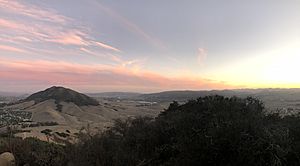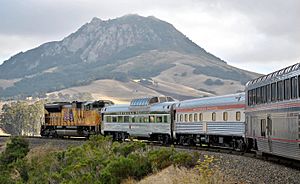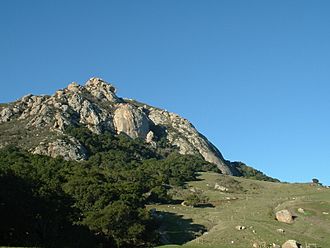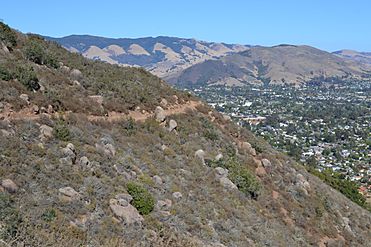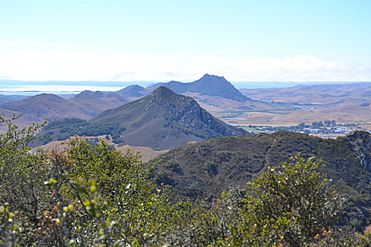Bishop Peak (California) facts for kids
Quick facts for kids Bishop Peak |
|
|---|---|
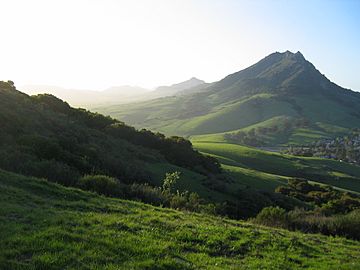
Bishop Peak from Cerro San Luis
|
|
| Highest point | |
| Elevation | 1,549 ft (472 m) NAVD 88 |
| Prominence | 1,086 ft (331 m) |
| Listing | Sierra Club Lower Peaks Committee |
| Geography | |
| Location | San Luis Obispo County, California, U.S. |
| Parent range | Santa Lucia Range |
| Topo map | San Luis Obispo |
| Geology | |
| Age of rock | 20 million years |
| Mountain type | Volcanic plug |
Bishop Peak is a tall mountain in San Luis Obispo, California. It stands about 1,546 feet (471 meters) high. This peak is the tallest of the "Nine Sisters". These are a chain of nine similar hills that stretch all the way to Morro Bay.
Many people think Bishop Peak is named for its shape, which looks like a bishop's hat (a miter). But it's actually named after the city of San Luis Obispo. "Obispo" is the Spanish word for "Bishop."
How Bishop Peak Formed
Like the other Nine Sisters, Bishop Peak is mostly made of a type of rock called dacite. About 20 to 25 million years ago, hot, melted rock called magma pushed up from deep inside the Earth. It stopped under a layer of softer rock and then cooled down.
Over millions of years, the softer rock above Bishop Peak slowly wore away. This process, called erosion, left behind the distinct, rugged shape we see today. Bishop Peak is known as a volcanic plug. This means it's the hardened core of an ancient volcano.
Plants and Animals
Bishop Peak has thin, rocky soil. This soil helps many special plants grow that are not common nearby. The area has different types of plant life. These include Oak woodlands, sage scrub, and chaparral.
In the woodland areas, you can find coast live oak and California bay trees. Other plants like poison oak and California blackberry also grow here. The scrub areas are home to many sweet-smelling types of sagebrush. You might also see coyote bush and monkeyflower.
Many birds live on Bishop Peak. There are lots of jays and other small passerine birds. You can also spot birds of prey like golden eagles, bald eagles, owls, and vultures. Mammals that call Bishop Peak home include deer, raccoons, and opossums. Larger animals like foxes, coyotes, bobcats, and even mountain lions also live there.
Exploring Bishop Peak
In the past, some stone was taken from Bishop Peak. This stone was used to build parts of the nearby city of San Luis Obispo. You can still see granite from the peak in old parts of the city. For example, it was used for curbs and even for the First Presbyterian Church.
Today, Bishop Peak is a protected area called the Bishop Peak Natural Reserve. It covers about 350 acres (1.4 square kilometers) of land. This land has been bought or donated since 1977 to keep it safe.
There are several trails for hikers to enjoy. You can start your hike from Patricia Drive or Highland Drive. The Felsman Loop Trail goes around the northeast side of the peak. It connects to the Bishop Peak Trail, which climbs up the south side to the very top. A hike from the Patricia Drive Trailhead is about 4.2 miles (6.8 kilometers) round trip. It climbs about 1,175 feet (358 meters) to the summit.
Gallery


